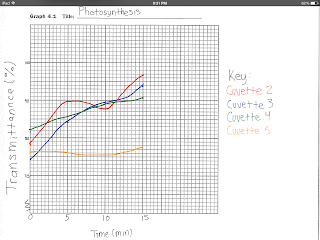Photosynthesis Lab
Purpose: the purpose of this lab is to prove that chlorophyll and chloroplasts are used in the production of oxygen in plants. Denaturation of spinach proteins were tested to show that chloroplasts were no longer useful when denatured. The independent variables were the drops of DPIP which were used to show that chlorophyll was actually functioning. The dependent variables was the light,as in the control sample we were able to completely block off all the light which was supposed to enter the cuvette with a piece of aluminum foil. We were also able to change the state of the spinach by using it either boiled or raw.
Purpose: the purpose of this lab is to prove that chlorophyll and chloroplasts are used in the production of oxygen in plants. Denaturation of spinach proteins were tested to show that chloroplasts were no longer useful when denatured. The independent variables were the drops of DPIP which were used to show that chlorophyll was actually functioning. The dependent variables was the light,as in the control sample we were able to completely block off all the light which was supposed to enter the cuvette with a piece of aluminum foil. We were also able to change the state of the spinach by using it either boiled or raw.
Introduction:The equation for photosynthesis is 6 CO2 + 6 H2O -> C6H12O6 + 6O2. Photosynthesis has 2 parts: the light reactions and the Calvin cycle. The light reactions occur in the thylakoid membrane, where water is split and oxygen is released and ATP and NADPH are produced. The Calvin cycle takes place in the Stroma and is powered by the ATP and NADPH produced by the light reactions in order to fixed CO2 into sugar. The function of the plant pigments is to absorb light and reflect it to the reaction centers during the light reactions. The relationship between light intensity and photosynthetic rate is directly proportional so the rate of photosynthesis increases as light intensity increases up until a certain point.
Methods: starting off the experiment, each of the cuvettes were filled with a spinach solution, either raw or boiled. DPIP was added to them as well, which was there to be eaten up by the chlorophyll as light reactions would function. If the DPIP was not eaten up and the solution remained blue, the chloroplasts did not function. A control cuvette used to recalibrate the sensor was made the same way as the previous cuvettes with the raw spinach, but it was wrapped in aluminum foil to prevent any sort of light from reaching the chloroplasts. Each of the cuvettes was left in the light for same amount of time, (5,10, and 15 minutes) and in the sensor for the same amount of time as well. This was to make sure everything was tested equally to provide us with the most accurate results.
Data:
First Trial
Second Trial
Graphs:
Discussion:
The first trial that we did there was no change in the color because we did not put enough Dpip into the solution because all the Dpip was used up right away and it was impossible to tell the difference over time. So we increased the concentration of the Dpip in order to be able to better see the change in Dpip used. In the experiment one can determine the amount of Dpip used because the translucency in the solution will become closer to 100%. Ans when The Dpip is not used the colorometer will read something less than 100% because the bluish tint will bring down the translucency.
Conclusion:
As the graph shows, the unboiled light and the unboiled dark were the only solutions to significantly increase in the translucency. the unboiled light was as predicted because it would be the only one that the chloroplasts will be using the light to consume the Dpip. And the only logical reason we can think of why the unboiled dark increased in translucency is because during the short time where we took the sleeve off and put it in the colorometer the chloroplasts activated and consumed the Dpip.
Resources:
Campbell biology ninth edition





Your discussion and conclusion should reference actual data from your experiment. What was the questions you were trying to answer? How do we compare the first run to the second run of the experiment - where is the first graph?
ReplyDelete